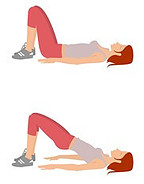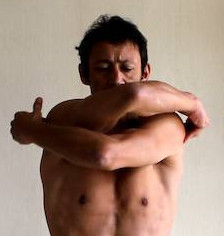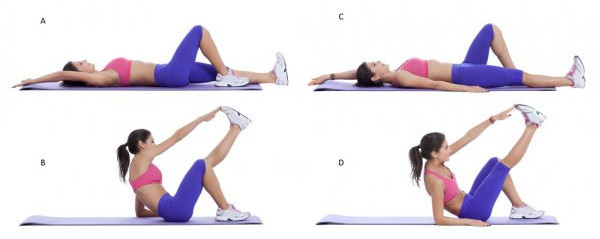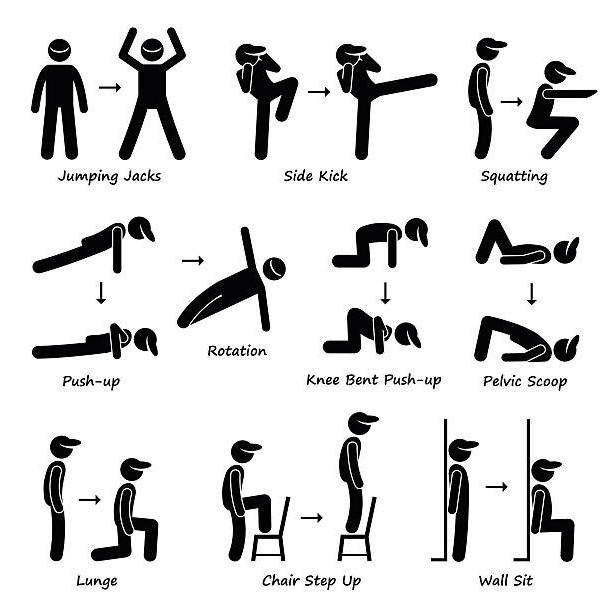Stretching is more important now than ever because so many work from home. Also, they sit at their desks for a long time. Because of our busy daily plans, we don’t have much time to move around. So, this post will be a complete guide to stretching that considers the problems our current way of life causes.
What does this stretching guide contain?
This stretching guide is short and very useful. It has two main parts that work together.
This article gives you much information about why you should start stretching regularly in the first part. In the next section, you’ll learn more about stretching basics, such as its different types and benefits. If you are searching for a way to improve your health and flexibility, this guide will provide everything you need.
You’ve been stretching.
Part 1: Stretching
What are the reasons to start stretching?
Regular exercise is essential for many reasons, especially with how we live now. Inactivity for long periods can increase the discomfort in the back area. Also, staying in uncomfortable poses for a long time can have the same impact. Furthermore, the chance of quick pain and damage to muscles and joints makes it clear how important it is to stretch every day.
People often go to the doctor for pain that comes on out of the blue, only to find that their bad habits are to blame. Thus, they need to be able to do more. In long-term pain, muscles get tight. Muscles and joints can get stiff from this.
The long hours and lack of movement in modern life worsen these problems. We can’t move around as much when we work from home or at our desks. Our environment makes it hard to live a healthy life, even though our joints naturally have a range of motion. So, to fight the harmful effects of being inactive, you must stretch often. In this way, it improves the health and movement of joints.
What does stretching mean?
Stretching, or flexibility, is when a muscle or tendon can get longer or wider without tearing or breaking. Stretching is more than just a physical trait; it’s a specific practice that works on certain muscles. This technique improves flexibility and suppleness by purposely stretching the muscle or tendon. Also, stretching can help improve the function of a muscle by making it a regular part of your practice. This is good for your muscles’ general health.
History of stretching
The stretching roots go deep into how people and animals act, and they often happen naturally. For example, the individual automatically stretches after a long time of sleeping or not moving.
In ancient Greece, Hippocrates and Galen, who knew that stretching could help with health problems, understood how important it was to try. Early recognition like this set the stage for understanding stretching as both a natural action and a purposeful, helpful activity.
Also, Japan has a long history of stretching beyond the West. One example is the Radio Taiso practice. Many people have worked out on Radio Taiso in the morning for over a hundred years. The fact that this stretching practice is so strict shows how important physical health is in this culture.
In ancient China, people practiced Tai Chi for a very long time. Additionally, Tai Chi uses controlled breathing and slow, deliberate moves to help people deal with stress. It started as a way to teach people self-defense. Later, it’s more of a whole-body workout that people often call “meditation in action.” The history of stretching goes through different societies. Also, it shows how it can be used in many different ways. In addition, its lasting importance is suitable for your physical and mental health.
The Muscles in the Human Body:

Muscles can tighten and loosen, which helps us move. Joints and ligaments work together to make this possible. When you stand stiff, you feel bad, which can hurt your body. Because of this, it is essential to do things that make our muscles shrink and lengthen.
These activities build and maintain their health—any muscle’s flexibility results from balanced tightening and stretching. Sometimes weak muscles contract excessively.
Benefits of Stretching Beyond Exercise:
Stretching regularly can have a positive effect and have many health benefits. The most common causes are:
1. Improving your posture
- Tight muscles, mainly in the hips and chest, can affect your standing stance.
- It improves flexibility and balance, which can help with posture problems.
2. Reduce Your Pain:
- Effectively reduces hip, knee, and back pain.
- It relieves muscular pain and discomfort, fostering a more comfortable daily experience.
3. Adaptability:
- It makes you more adaptable by increasing the range of motion in joints and muscles.
- Stretching helps the body become more flexible.
4. Tension Relief:
- At first, this exercise is a natural stress reliever that reduces muscle tension.
- Both the body and the mind feel calmer after stretching.
5. Improved Movement and Flexibility:
- Stretching makes it easier to move around.
- It makes you more flexible to prevent stiffness and maintain mobility.
6. Mind Relaxation:
- Stretching can help calm the mind.
- It lowers mental stress, which is good for your general health.
7. Headache Prevention:
- Reduces headaches caused by stress.
- It makes stress less severe on the muscles in the head and neck
8. Muscle Relaxation and Tension Reduction:
- Promotes muscle relaxation.
- Effectively reduces overall muscle tension, aiding in relaxation.
9. Improved blood flow:
- Enhances blood circulation to muscles.
- It optimizes the supply of nutrients and oxygen to tissues and supports muscle health.
10. Cardiovascular Benefits:
- heart rate and blood pressure go down because of elongation and
- improves blood flow and heart health, which is good for cardiovascular health.
Before a workout:
Pre-Exercise Stretching:
- Warming Up the Body:
- It helps you start exercising slowly and at a low level.
- This pre-stretching helps muscles get ready for more exercise and blood flow.
- Promoting Muscular Action:
- It makes you more flexible.
- Get your muscles ready to do more hard physical work.
- It lowers the chance of getting hurt while exercising.
Post-Exercise Stretching:
- Injury Prevention:
- Giving your muscles 10 to 15 minutes to recover after working out lowers the risk of injury.
- It is especially helpful for tasks that require lifting big things.
- Facilitating muscle recovery:
- Elongation helps the muscles slowly get back to their resting state.
- It makes you more flexible and less stiff after a workout.
- Stretching helps keep muscles healthy.
Stretching before and after exercise is a complete way to improve fitness. It also avoids accidents and keeps muscles healthy.
Stretching means or ways:
-
Types of stretching:
-
Static Stretching:
- Description: holding a certain movement for at least 10 seconds.
- Timing: This is usually done after activities that make you more flexible.
- Benefits: It makes muscles more relaxed and less stiff after working out.
-
Dynamic Stretching:
- Description: Activities that you do before exercise to get the body ready
- Characteristics: It involves controlled moves similar to the next workout’s parts.
- Benefits: It works out muscles, boosts blood flow, and extends your range of motion.
-
Passive Stretching:
- Description: determining the range of motion with external assistance.
- Execution: Often performed by a physiotherapist or caretaker.
- Applicability: Beneficial for individuals with limited mobility, such as those with hemiplegia or paralysis.
-
Active Stretching:
- Description: The person must be able to move around on their own.
- Use Case: This exercise is often used to help people recover from strokes.
- Purpose: To improve motor function and stimulate brain messages in people healing from a stroke.
-
Active-Assistive Stretching:
- Description: Combines action on your own with help from outside sources.
- Use Case: It is beneficial for stroke survivors to regain motor control gradually.
- Application: It helps with recovery by promoting controlled movement and making muscles more flexible.
Understanding the diverse forms of stretching allows individuals to tailor their routines based on specific needs and goals. Whether preparing for exercise, recovering from injury, or undergoing rehabilitation, choosing the proper stretching method is essential for optimizing results and promoting overall well-being
muscles.

-
-
Additional Stretching Techniques:
- Ballistic Stretching:
- Description: Involves rapid, activating actions to strengthen muscles.
- Characteristics: Utilizes dynamic movements that challenge the muscle’s range of motion.
- Purpose: Enhances flexibility and contributes to improved muscle function during exercise.
- PNF Stretching (Proprioceptive Neuromuscular Facilitation):
- Approach: Increasing a muscle’s length using this stretching technique.
- Consideration: This requires careful application to avoid potential muscle damage.
- Application: Commonly employed in rehabilitation settings to improve flexibility and muscle control

- Ballistic Stretching:
Effective Stretching Routine: Insights from Joe Yoon
In the realm of stretching exercises, various methodologies abound. Still, Joe Yoon offers a concise and potent routine under the formula “4+1,” entailing four stretching exercises paired with a strengthening exercise, each lasting 9 minutes.
Key Recommendations:
-
Consistent Routine:
- Advice: Follow a consistent routine of four stretching and strengthening exercises.
- Example: Begin with comprehensive stretches targeting the spine and hips, incorporating exercises like the T-spine stretch, followed by the pigeon exercise to engage the extremities.
-
Versatility in Stretching:
- Guidance: Perform stretches in diverse ways to enhance flexibility and overall effectiveness.
- Example: Experiment with variations to maximize the impact of each stretch, ensuring a holistic approach to the routine.
-
Mindful Breathwork:
- Preparation: Take a deep breath before initiating any movement.
- Importance: Deep breathing primes the body for optimal stretching and strengthens the mind-body connection.
-
Thorough Stretching:
- Approach: Stretch until you feel the full range of motion.
- Emphasis: Prioritize thorough stretches to unlock the full potential of each exercise.
-
Strategic Focus:
- Recommendation: Concentrate on different muscle groups during each repetition for comprehensive results.
- Example: Divert attention to specific areas with each iteration to ensure a balanced and well-rounded impact.
-
Consistency and Reset:
- Philosophy: Regular exercise leads to increased potency, with each activity serving as a reset for the body.
- Advice: Embrace frequent workouts to experience enhanced strength and flexibility over time.
As encapsulated in “Better Stretching” (2015), Joe Yoon’s insights advocate for a routine and a mindful and strategic approach to stretching exercises. By combining versatile stretching techniques, conscious breathwork, and strategic focus, individuals can unlock the transformative power of stretching for improved physical well-being.
There are many different stretching exercises. Each exercise targets a specific area; you should know what you are targeting for each exercise. In general, any constant activity can lead to muscle stiffness, and you can try these exercises to enhance the mobility of muscles and organs. Also, you can look at the practices and the references at the end of the article.
A- Neck:
Alleviating Neck Tensions: Insights from Joe Yoon’s Recommendations
Muscle tensions often result from prolonged periods in static positions, such as during sleep or extended phone calls. Neck muscle discomfort can stem from various factors, including carrying heavy objects or sudden head movements. This discomfort can lead to aches and strains. To address and mitigate these issues, Joe Yoon suggests neck exercises designed to relieve pain and enhance flexibility.
Key Considerations:
- Understanding the Causes:
- Insight: Identify potential causes of neck discomfort, such as extended periods in one position or strained movements.
- Example: Recognize the impact of heavy object lifting or sudden head motions on neck muscle aches.
- Addressing Muscle Strain and Sprain:
- Cause Recognition: Acknowledge that muscle strain and sprain commonly contribute to muscle tearing.
- Preventive Measure: Engage in neck exercises to proactively reduce pain and achiness associated with muscle tension.
Neck Exercises (By Joe Yoon’s Recommendations):
-
Neck Side Exercise:
- Guidance: Focus on training the lateral muscles of the neck.
- Reminder: Before initiating the movement, take a deep breath for enhanced effectiveness.
-
Neck Back Exercise:
- Objective: Strengthen the muscles at the back of the neck.
- Best Practices: Emphasize a deliberate and controlled stretching routine, ensuring optimum impact.
-
Neck-Back Diagonal Exercise:
- Purpose: Work on diagonal muscles to enhance overall neck flexibility.
- Advice: Listen to your body’s cues and proceed comfortably.
-
Neck Front Exercise:
- Target Area: Focus on the muscles at the front of the neck.
- Crucial Reminder: Incorporate slow and deliberate movements, paying attention to your body’s responses.
-
Neck Front Diagonal Exercise:
- Objective: Engage in exercises targeting the frontal diagonal muscles.
- Body Awareness: Remain attuned to your body’s signals, ensuring a mindful and effective practice.
Fundamental Principles for All Exercises:
- Breath Awareness: Initiate each movement with a conscious, deep breath.
- Pacing: Take time during stretches, prioritizing a controlled and deliberate approach.
- Listening to Your Body: Pay attention to your body’s feedback, adjusting movements to prevent strain or discomfort.
By incorporating these neck exercises, complemented by breathwork and mindful pacing, individuals can effectively address and alleviate neck tensions while promoting overall neck health.

B- Shoulders and Chest: Unveiling Joe Yoon’s Recommended Exercises
First, doing movements for the neck sets the stage for working on problems in the shoulders and chest. It lets you take a whole-person approach to upper-body health. Second, it’s important to figure out what might be causing stiff shoulders and chests, especially in sports that involve doing the same thing over and over. Also, chest pain could be a sign of heart problems. So, this post is mostly about stiffness and suggests certain workouts that can help ease the pain.
Causes of Stiff Shoulders and Chest:
-
Repetitive Sports Movements:
- Insight: Stiffness can result from engaging in sports that involve repetitive shoulder and chest motions.
- Example: Sports like swimming or weightlifting may contribute to muscle tightness and discomfort.
-
Cardiac Consideration:
- Note: While chest pain could be linked to cardiac issues, this essay emphasizes stiffness-related aspects.
- Scope: Discuss exercises to enhance flexibility and alleviate stiffness in the chest and shoulders.
Recommended Exercises:
- Front-Side Shoulders Exercise:
- Focus Area: The muscles on the front of the shoulders
- Implementation: Move slowly and carefully, focusing on slow stretches to improve flexibility.
- Backside Shoulder Workout:
- Objective: Strengthen the muscles on the backside of the shoulders.
- Best Practices: Also, move slowly and deliberately to improve the health of your shoulder muscles.
- Chest Exercise for the Collarbone:
- Target Region: Concentrates on the chest muscles around the collarbone.
- Execution: Employ specific exercises that address this region for comprehensive chest mobility.
- Rib cage exercise for the breastbone:
- Focus Area: Targets the rib cage and breastbone region.
- Guidance: Perform exercises designed to alleviate stiffness and promote flexibility in the chest.
Practical Advice for Optimal Results:
- Sequential Approach: Do your exercises in a sensible order, starting with neck exercises and moving on to activities that work your shoulders and chest.
- Consistency: Do these routines regularly to gradually loosen up stiff muscles. Thus, it improves upper-body movement.
- Note of Caution: If chest pain lasts long or worsens, you should see a doctor to rule out heart problems.




c- Back:
Initiating with neck, shoulder, and chest exercises lays the groundwork for a comprehensive approach to back health. First, the spinal cord, which is an essential part of the back, supports 50% of our body weight, keeping us upright and protecting key systems like the heart and lungs. Second, it is specifically made to keep health up. Also, these workouts are designed to help you feel better after doing the same things over and over or taking long breaks. In this way, they make sure that this vital part of our bodies stays healthy.
-
Lower back (flexion):
- knees to chest

- lower legs extended

- legs over head

- chest to thigh

- backward pull, seated. This exercise can be done in 2 ways: on a chair and on the floor.

- Hug and release, seated

- knees to chest
-
lower back (extension):
- Chest and pelvic lift

- Sacrum lift, or kneeling, can be done in two ways, as shown in this picture: by standing on knees and pushing the back forward using the arms.

- The towel under the pelvis is similar to the exercise before, but there is a rounding towel instead of a cube.
- Chest and pelvic lift
-
Upper back ( flexion):
- crossed-elbows hug

- backward pull standing

- crossed-elbows hug
-
upper back (extension):
- Towel under ribs: For this practice, the towel is under the ribs.
- Long arms on all fours
In this exercise, you will extend all four members by pushing up your upper area.

D- Abdominal Exercises:


E- Arms, Wrists, and Hands:



F- Hips:

G- Thighs and legs exercises:

H- Calves:

I-Feet, toes, and ankles:
- Foot and ankle exercises make moving your toes and feet easier, leading to a better, healthier life.
- One of their perks is that they make long days less painful.

You can also choose many exercises, but it’s a good idea to create a weekly plan that covers activities for the whole body.
References:
1- Minarik, Linda. ( 2015). Stretching with ease( Birch, Jane)).Cindy Richards.
2- Yoon, Joe.Better Stretching.us.macmillanusa.com/piracy.
